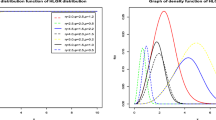Abstract
It is well known that in the case of independent random variables, the (reversed) hazard rate of the (maximum) minimum of two random variables is the sum of the individual (reversed) hazard rates and hence the onotonicity of the (reversed) hazard rate of the marginals is preserved by the monotonicity of the (reversed) hazard rate of the (maximum) minimum. However, for the bivariate distributions this property is not always preserved. In this paper, we study the monotonicity of the (reversed) hazard rate of the (maximum) minimum for two well known families of bivariate distributions viz the Farlie-Gumbel-Morgenstern (FGM) and Sarmanov family. In case of the FGM family, we obtain the (reversed) hazard rate of the (maximum) minimum and provide several examples in some of which the (reversed) hazard rate is monotonic and in others it is non-monotonic. In the case of Sarmanov family the (reversed) hazard rate of the (maximum) minimum may not be expressed in a compact form in general. We consider some examples to illustrate the procedure
Similar content being viewed by others
References
Bairamov I., Kotz S., Gebizlioglu OL. (2001). The Sarmanov family and its generalization. S Afr Stat J 35:205–224
Bairamov I., Kotz S. (2002). Dependence structure and symmetry of Huang-Kotz FGM distributions and their extensions. Metrika 56:55–72
Barlow RE., Marshal AW., Proschan F. (1963). Properties of the probability distribution with monotone hazard rate. Ann Math Statist 34:375–389
Block HW., Savits TH., Singh H. (1998). The reversed hazard rate function. Prob Eng Inform Sci 12:69–90
Chandra NN., Roy D. (2001). Some results on reversed hazard rate. Prob Eng Inform Sci 15:95–102
Eeckhoudt L., Gollier C. (1995). Demand for risky assets and the monotone probability ratio order. J Risk Uncertain 11:113–122
Glaser RE. (1980). Bathtub and related failure rate characterizations. J Am Stat Assoc 75:667–672
Gupta PL., Gupta RC. (1997). On the multivariate normal hazard. J Multivar Anal 62(1):64–73
Gupta RC. (2002). Non-monotonic failure rates and mean residual life functions. In: Hayakawa, Irong, Xie (eds). System and bayesian reliability. World Scientific, New Jersey, pp. 147–163
Gupta RC., Warren R. (2001). Determination of change points of non-monotonic failure rates. Commun Stat 30:1903–1920
Gupta RD., Nanda AK. (2001). Some results on reverse hazard rate ordering. Commun Stat 30:2447–2457
Kalbfleisch JD., Lawless JF. (1989). Inference based on retrospective ascertainment: an analysis of the data on transfusion-related AIDS. J Am Stat Assoc 84:360–372
Kijima M., Ohinishi M. (1999). Stochastic orders and their application in financial optimization. Math Methods Oper Res 50:351–372
Lagakos SW. (1979). General right censoring and its impact on the analysis of survival data. Biometrics 35:139–156
Lee HLT. (1996). Properties and applications of the Sarmanov family of bivariate distributions. Commun Stat 25:1207–1222
Nagaraja HN., Baggs GE. (1996). Order statistics of bivariate exponential random variables. In: Nagaraja, Sen, Morrison (eds). Statistics theory and applications. Springer, Berlin Heidelberg New York
Raftery AE. (1984). A continuous multivariate exponential distribution. Commun Stat 13:947–965
Sengupta D., Nanda AK. (1999). Logconcave and concave distributions in reliability. Naval Res Logist Q 46(4):419–433
Slud E., Byar D. (1988). How dependent causes of death can make risk factors appear protective. Biometrics 44:265–269
Willett PK, Thomas JB (1985) A simple bivariate density representation. In: Proceedings of the 23rd annual allertan conferance on communicating control and computing, pp 888–897. Urbana-champaign: coordinated science laboratory and Departement of Electrical and Computer Engineering, University of Illinois
Willett PK., Thomas JB. (1987). Mixture models for underwater burst noise and their relationship to simple bivariate density representation. IEEE J Oceanic Eng 12:29–37
Author information
Authors and Affiliations
Corresponding author
Additional information
Research of the second author is supported by a grant from Natural Sciences and Engineering Research Council and the research of the other two authors is partially supported by a travel grant from the Canadian American Center of the University of Maine
Rights and permissions
About this article
Cite this article
Gupta, R.C., Gupta, R.D. & Gupta, P.L. Monotonicity of the (reversed) hazard rate of the (maximum) minimum in bivariate distributions. Metrika 63, 223–241 (2006). https://doi.org/10.1007/s00184-005-0014-y
Received:
Accepted:
Published:
Issue Date:
DOI: https://doi.org/10.1007/s00184-005-0014-y




